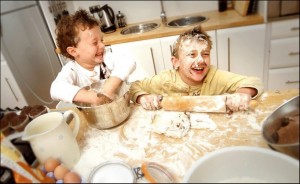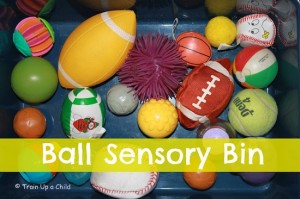Some moms, I have heard, are neat freaks. Their homes and their children, it is rumored, are kept sparkling clean, orderly, on time, with bows tied and shoes on the correct feet. I admit I have never quite been that kind of mom. Maybe that’s because I like to get messy.
When you get messy on purpose, you’re exploring. You’re learning and creating. And it’s so much fun! Has there ever been an art project without at least a little mess? Cooking in the kitchen without drips or spills? Gardening without dirt on your clothes?
You’re doing your kids a huge favor when you let them get messy. Giving them opportunities to touch, taste, see, hear, and smell is the kind of exploration that builds connections in their little brains, and leads to expanded capacity for learning and creativity.
This kind of sensory input is particularly important in the infant, toddler and preschool years because the young brain responds so readily by forming new synapses, and strengthening those connections that are stimulated.
Now, if you’re going to keep your kids safe and keep your own sanity, you don’t want to let your toddler explore your cell phone, or sharp knives, or objects smaller than the diameter of a toilet paper tube that could cause choking (especially between the ages of 3 months and 3 years, when most kids put everything in their mouths). And you can’t let your kids have “messy time” all day every day, anywhere. But planning how and when to get messy can be the best kind of fun your kids can have at home.
Here are some ideas about how to get messy, and love it:
- For quick clean-up, have a stack of fabric shower curtains or tablecloths to spread out under your messy activity. When messy time is over, just shake the cloth outside and toss it in the washer.
- Set up “sensory bins”, each container with its own theme (shapes, textures, colors, flavors, aromas, sounds, etc.), for your child to play with. Sensory bins contain the mess and define the activity, and make clean-up simpler. Here are ideas for several different sensory bins that are great for “messy time” with toddlers – all the items are safe for putting in the mouth or even eating.
- It’s actually a good thing to let your kid throw things off the high chair tray. Kids are little scientists learning about gravity! This phase of scientific exploration usually only lasts a few days or weeks at the most, so enjoy it while you can (if you can!). Refer to tip #1 about the shower curtain – this works well under the high chair.
- Keep art supplies stashed away for rainy or restless days: paper, markers, kid scissors, glue, string and beads, sidewalk chalk, window crayons, modeling clay or dough, finger paints or watercolors or tempera paints, coffee filters, cupcake papers, a can of whipped cream … and on and on and on. Stock up at the dollar store or make some things yourself. Here are some nifty art ideas from KinderArtLittles for 1 to 5 year olds, and more ideas from KinderArt for age 5 through 18.
- To minimize getting paint (or marker, or ink, or glue, or glitter …) on clothes or skin, cover up with dad’s old button-up shirts. Turn the shirt around backwards, buttons in the back. Toss the shirt in the wash when you are done, then hang it up for next time.
- Have messy time in the bathtub. When you’re done, just rinse the tub!
The job of childhood is to play, to explore, to learn. This task is not always neat. Find ways to delight and teach your child by getting messy on purpose. You’ll both love it!
P.S.: One last thought on this topic – If you discover your child in the middle of a mess, don’t necessarily get upset or hurry to clean it up. Take time to laugh about it; take a quick picture before the clean-up starts. As long as it’s not a dangerous situation, that mess may be one of your child’s happiest and most memorable moments.

